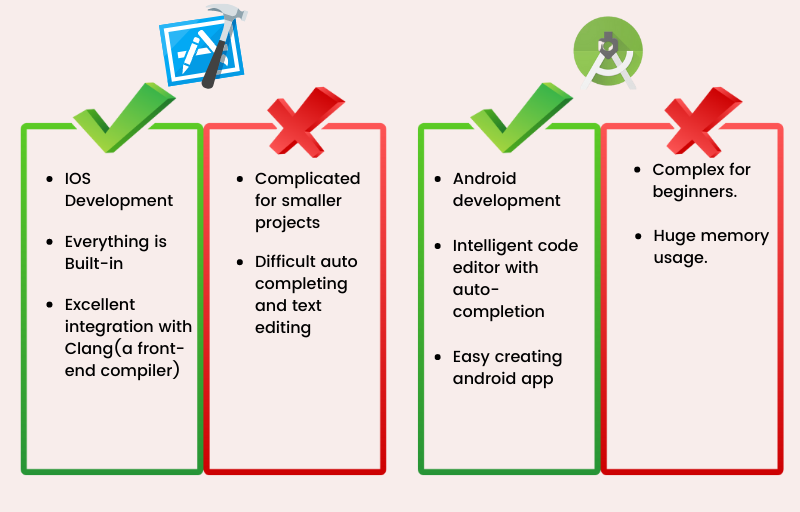iOS vs. Android App Development Differences
The mobile app industry has been growing exponentially, with countless apps created daily to cater to the various needs of the global population.
Two powerful platforms dominate the market: iOS, developed by Apple, and Android, developed by Google.
Let’s explore the key differences between iOS and Android app development to provide a better understanding of choosing the right platform for your mobile app development company.
Keeping the audience in mind, developers must find a way to let the crowd visit their site and have a high return on investment.
Related: What You Need To Know Before You Develop A Mobile App
Looking further into this article, we can see the apparent differences under these topics:
1. Design Guidelines: iOS vs. Android
2. Development Environment: A Closer Look at Xcode and Android Studio
3. Development Languages: Obj C/Swift vs. Java/Kotlin
4. Market Share: iOS vs. Android
Design Guidelines: iOS vs. Android
![[In-article 3] OS vs. Android App Development Differences](https://gyanmatrix.com/wp-content/uploads/2023/04/In-article-3-iOS-vs.-Android-App-Development-Differences.png)
Design philosophies play a vital role in shaping the user experience of apps on the iOS and Android platforms. Therefore, these guidelines are essential to maintaining a consistent user experience across apps on each platform.
iOS
Apple provides the Human Interface Guidelines, emphasizing a clean, minimalist design. This approach focuses on user experience and ensures that apps have a coherent look and feel, making them easily recognizable as iOS apps. In addition, Apple’s guidelines prioritize user-friendly navigation, consistent font usage, and intuitive app layouts.
Android
Google’s Material Design offers developers a flexible design system with many components and customization options. This design philosophy encourages the creation of unique and responsive Android apps that cater to various devices and screen sizes. In addition, the material design focuses on visual hierarchy, animations, and an adaptable layout to provide a seamless user experience across Android devices.
By understanding and following the differences in design philosophy, developers can create visually appealing and user-friendly apps that adhere to the standards and expectations of each platform.
Development Environment: A Closer Look at Xcode and Android Studio

Let’s look at the development environments for mobile app development companies specific to each platform.
Xcode
Xcode is Apple’s official integrated development environment (IDE) for creating iOS apps. Xcode supports Swift and Objective-C, the primary languages for iOS app development. It integrates seamlessly with Apple’s platforms, frameworks, and services, ensuring smooth and efficient development. In addition, Xcode offers a live preview feature, allowing developers to see their interface designs in real-time.
Android Studio
Android Studio, developed by Google, is the official IDE for creating Android apps. Java and Kotlin are the primary languages for Android app development. It provides a wide array of tools, including a code editor with intelligent code completion, a visual layout editor, and extensive debugging tools. Android Studio also includes an emulator for testing apps on various devices and screen sizes.
When choosing a development environment, mobile app development companies should consider compatibility with developers’ operating systems, aligning with their expertise, and selecting an environment that meets project requirements to contribute to a streamlined development process and successful app launches.
Development Languages: Obj C/Swift vs. Java/Kotlin
Here are the key aspects of the programming languages that mobile app development companies employ on each platform.
iOS Programming Languages
Apple introduced Swift in 2014, the preferred language for iOS app development. It is a modern, powerful, expressive language designed to read and write easily. Swift features type inference, optionals, and error handling, resulting in cleaner and safer code.
Furthermore, Swift is open-source, and its performance is on par with or better than Objective-C, allowing for faster app development and execution.
Objective-C is an older programming language for iOS app development. It is a superset of the C programming language and utilizes a dynamic runtime environment. While Apple still supports Objective-C, its popularity has declined in favor of Swift due to Swift’s improved syntax, safety, and performance.
Android Programming Languages
Kotlin, officially supported by Google for Android app development since 2017, is fully interoperable with Java, allowing developers to use both languages within the same project.
It offers a more concise and expressive syntax than Java, producing more readable and maintainable code. In addition, Kotlin’s safety features, such as null safety and extension functions, help prevent common programming errors, making it an attractive choice for Android development.
Java has been the primary language for Android app development. It is a widely-used, object-oriented language with a large developer community and extensive libraries. However, Java’s verbosity and lack of modern features have led to Android developers’ growing preference for Kotlin.
Choosing a programming language for mobile app development companies depends on developer expertise. Aligning the platform with developers’ skills ensures a smooth development process and better code quality, efficiency, and maintainability.
Market Share: iOS vs. Android
When deciding between iOS and Android app development, market share and revenue generation are two essential factors that must be considered.
Here, we explore these factors to help mobile app development companies make better decisions.
Market Share
Android’s dominance in the global market share is primarily due to its open-source nature, which allows for more affordable devices and broader availability. This more significant market share offers mobile app development companies a vast potential user base for their Android apps, increasing the likelihood of app adoption.
On the other hand, iOS has a smaller market share, as Apple’s devices are typically more expensive and exclusive. However, this exclusivity often leads to a more loyal and engaged user base, with higher retention rates and frequent app usage.
Revenue Generation
Although Android boasts a larger market share, iOS users are known to generate more revenue per app. iOS users typically have higher disposable incomes and are more willing to spend on app purchases and in-app transactions. As a result, companies targeting iOS users may experience higher returns on investment (ROI) and better monetization outcomes.
Conversely, while Android apps can reach more users, they often generate lower revenues per user. This can be attributed to the diverse range of Android devices and the tendency of Android users to prefer free or ad-supported apps.
The choice between iOS and Android for app development ultimately depends on various factors, including the target audience, business goals, and development resources.
By understanding the key differences between these platforms, mobile app development companies can make better decisions that align with their objectives, ensuring their apps’ successful launch and growth.
SaaS Development Company in India: Why India Leads the Global SaaS Innovation Curve
SaaS Development Company in India: Why India Leads the Global SaaS Innovation Curve The ...
Top Digital Transformation Companies: Pioneering Innovation in the Modern Business Era
In an era where technology underpins every facet of business, digital transformation is no ...
7 Strategic Reasons Why GCC India Is the Silent Engine Behind Tech Giants’ Growth
Global Capability Centers in India have quietly transformed into innovation powerhouses, playing a pivotal ...
Global Capability Center India: Strategic Growth Engine for Global Enterprises
Executive Summary Global Capability Center India is evolving far beyond traditional offshore service models into ...
Unleashing Blockchain development: Driving Business Efficiency and Innovation
Blockchain Development is no longer just a buzzword—it’s a game-changer for businesses across industries.From enhancing ...
Scale Your Business Through GyanMatrix – Your Trusted Partner for Global Growth
In today’s rapidly evolving business landscape, scaling your company efficiently while managing costs and maintaining ...









